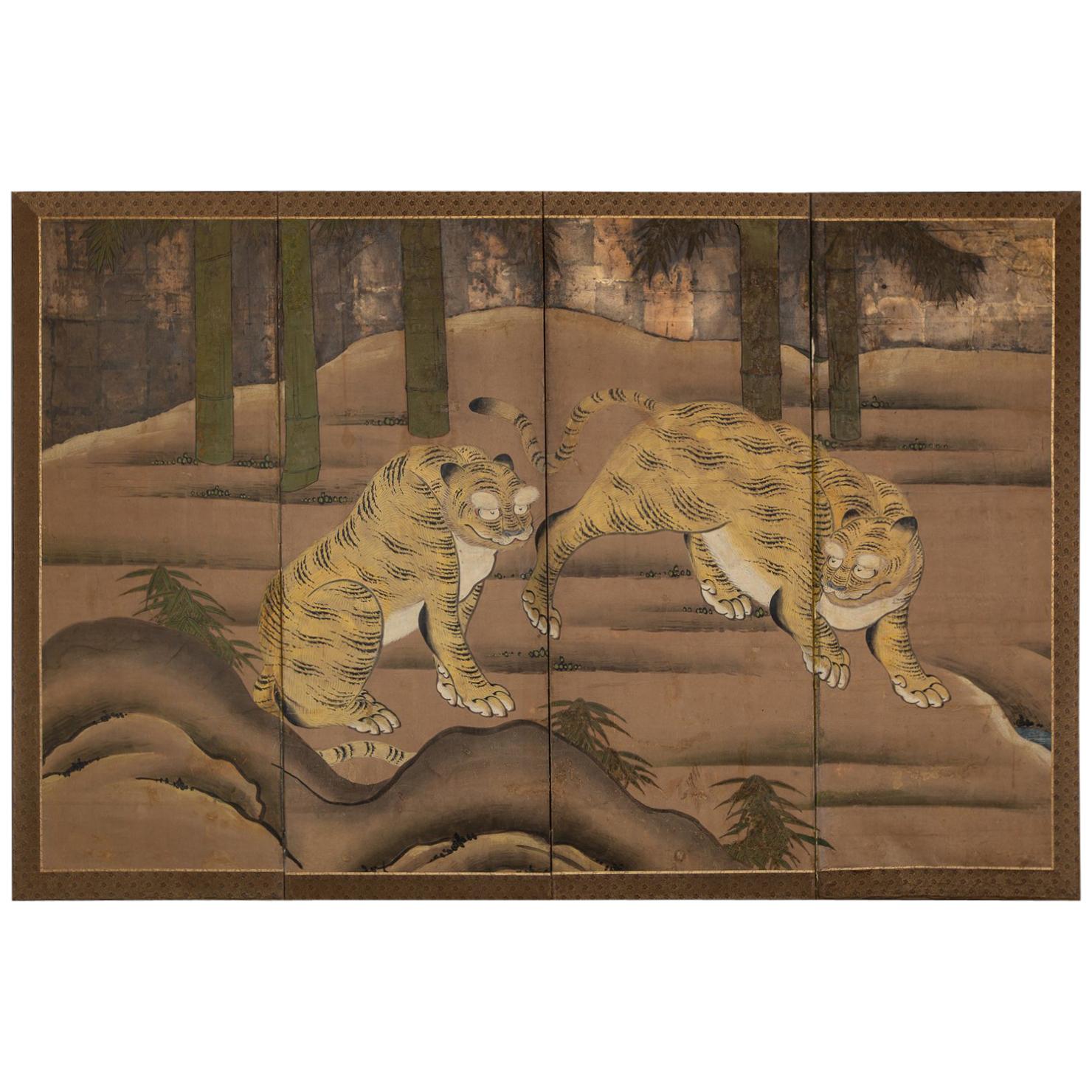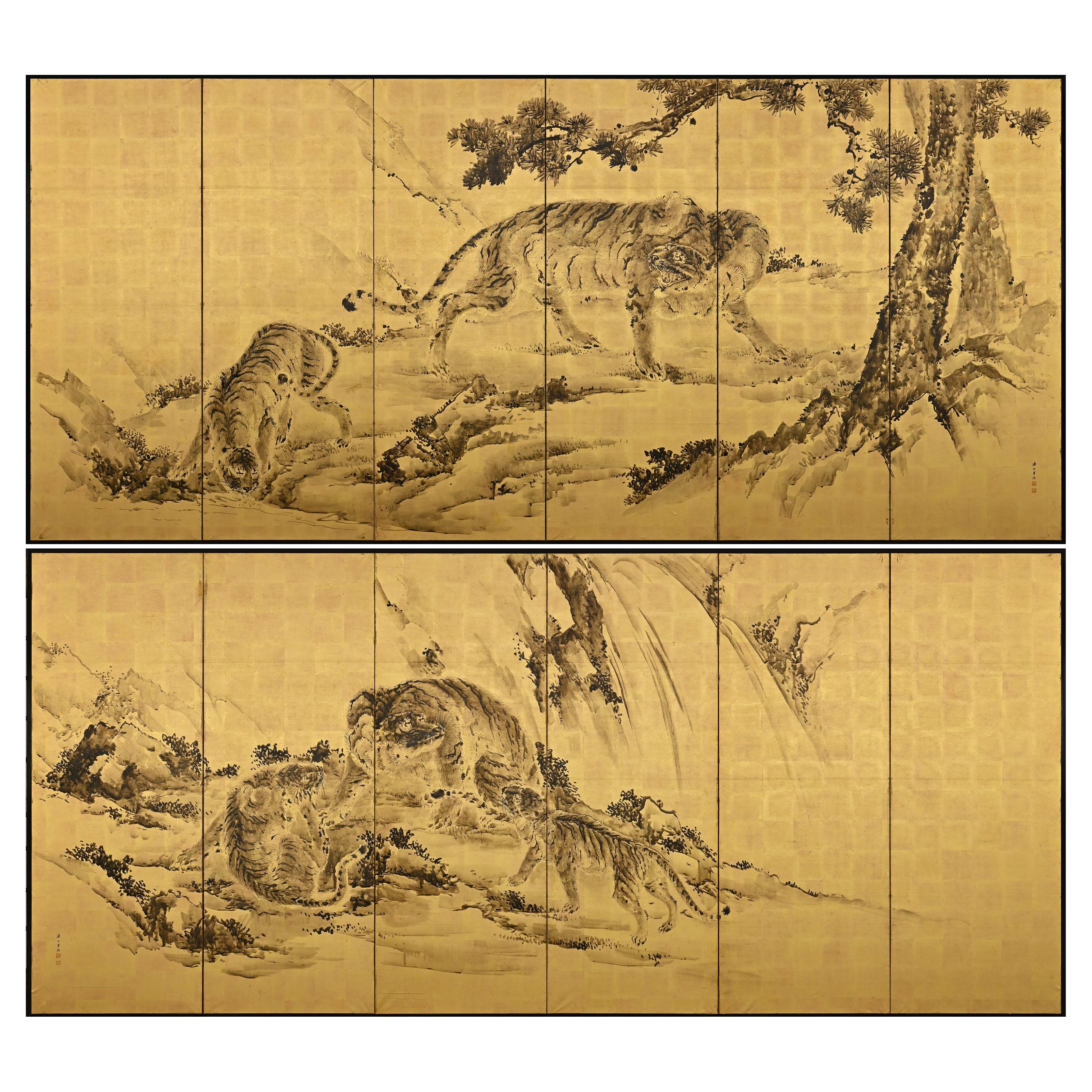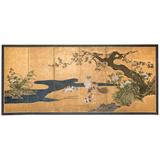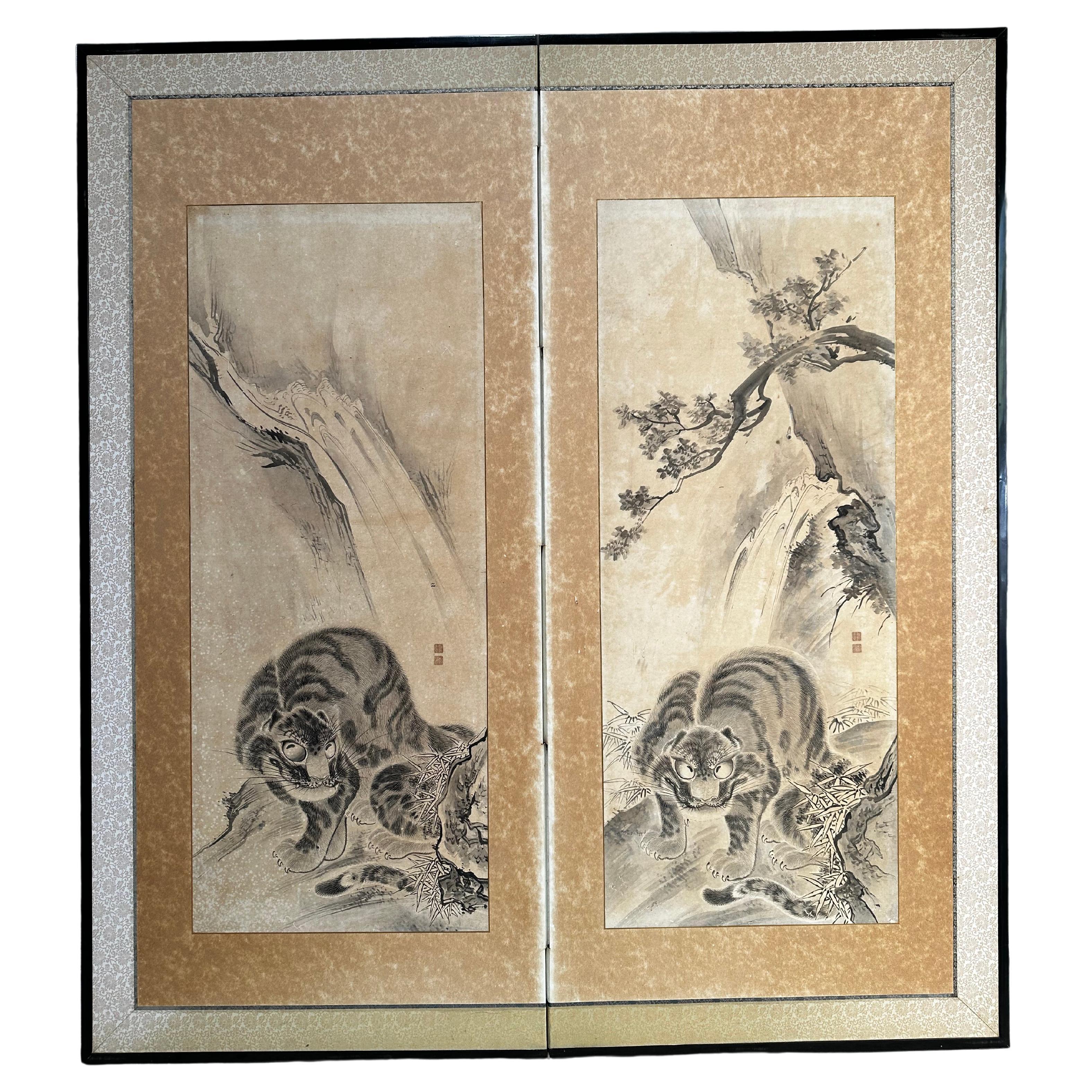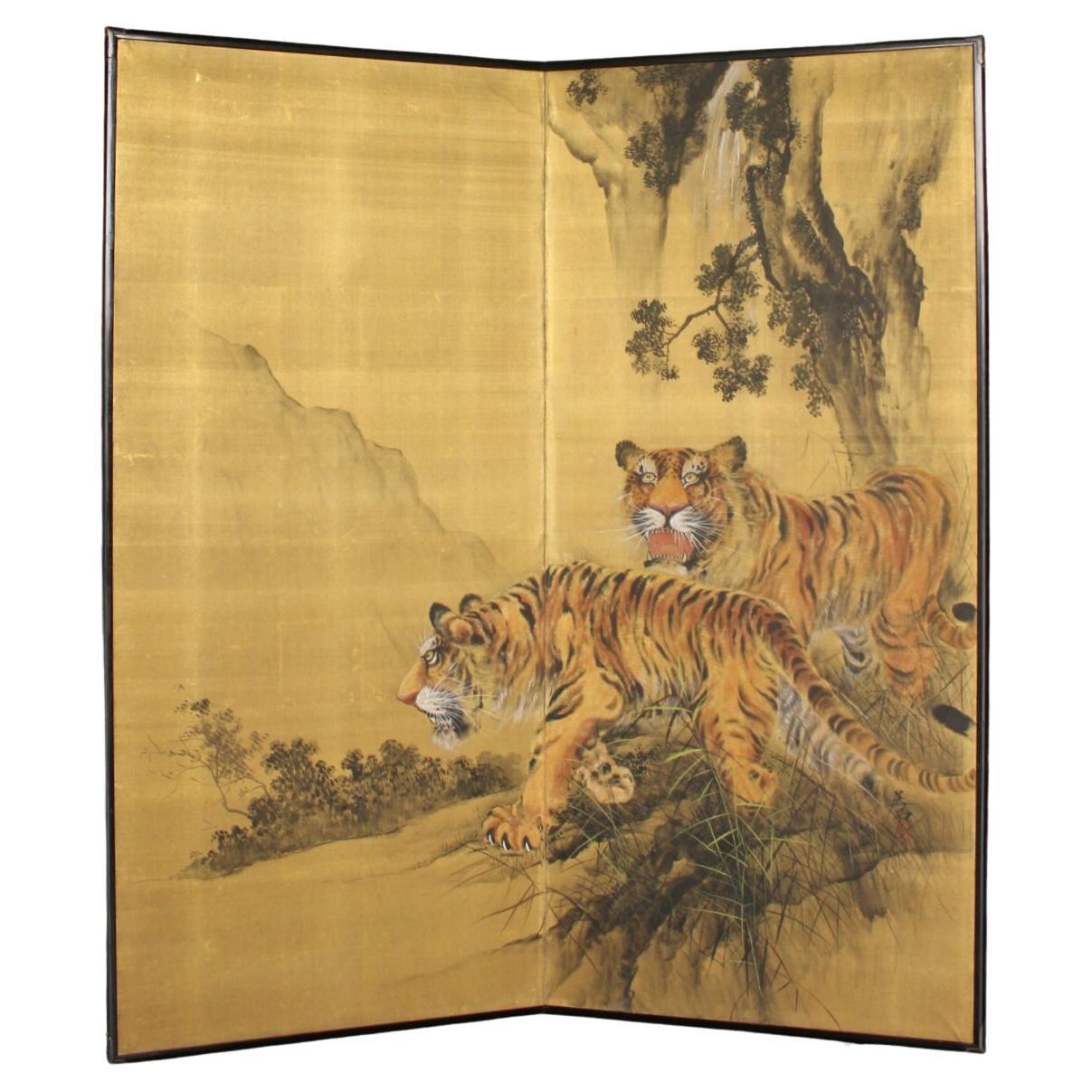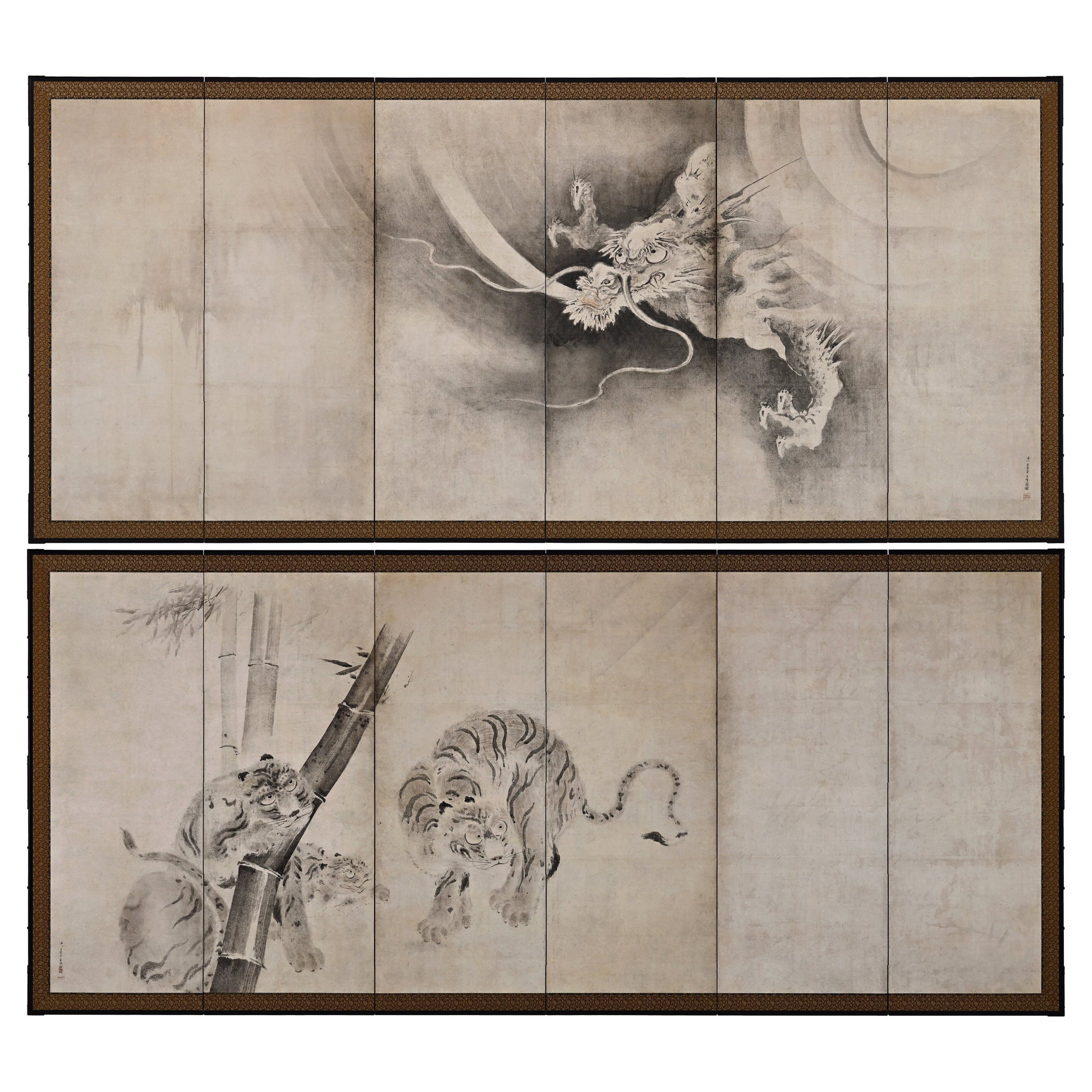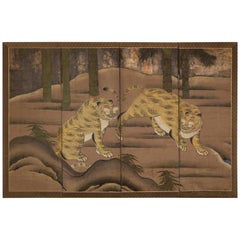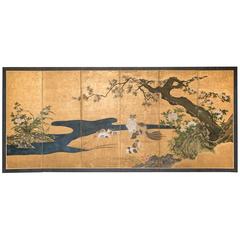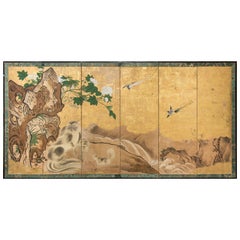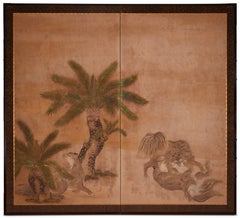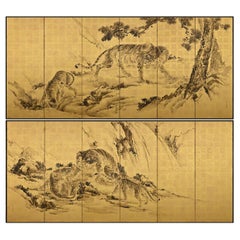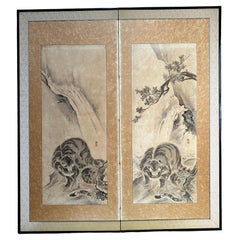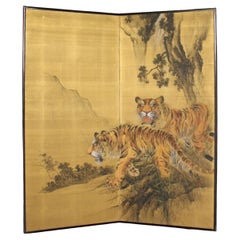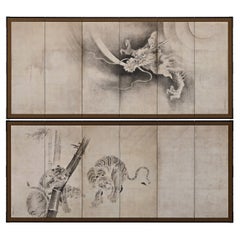Items Similar to Japanese Two-Panel Screen "Leopard with Cubs"
Want more images or videos?
Request additional images or videos from the seller
1 of 7
Japanese Two-Panel Screen "Leopard with Cubs"
$37,000
£28,102.41
€32,467.57
CA$51,856.84
A$58,037.55
CHF 30,291.14
MX$707,758.98
NOK 387,685.40
SEK 366,993.87
DKK 242,301.18
Shipping
Retrieving quote...The 1stDibs Promise:
Authenticity Guarantee,
Money-Back Guarantee,
24-Hour Cancellation
About the Item
With gold clouds on gold leaf with camellia on river's edge.
In history, Japanese artists did not see leopards or tigers in real life because the animals were not native to Japan, they lived in China. Artists were only exposed to skins and stories brought in from abroad. Some artists assumed that leopards were female tigers and depicted them as such. That could explain why there are tiger cubs with a leopard mother in this screen.
- Dimensions:Height: 69.75 in (177.17 cm)Width: 75.5 in (191.77 cm)Depth: 1 in (2.54 cm)
- Materials and Techniques:
- Place of Origin:
- Period:
- Date of Manufacture:Mid-19th Century
- Condition:Details on request.
- Seller Location:Hudson, NY
- Reference Number:Seller: S15721stDibs: LU85519968173
About the Seller
5.0
Recognized Seller
These prestigious sellers are industry leaders and represent the highest echelon for item quality and design.
Established in 1971
1stDibs seller since 2008
166 sales on 1stDibs
Typical response time: 17 hours
Associations
The Art and Antique Dealers League of AmericaAntiques Associations Members
- ShippingRetrieving quote...Shipping from: Hudson, NY
- Return Policy
Authenticity Guarantee
In the unlikely event there’s an issue with an item’s authenticity, contact us within 1 year for a full refund. DetailsMoney-Back Guarantee
If your item is not as described, is damaged in transit, or does not arrive, contact us within 7 days for a full refund. Details24-Hour Cancellation
You have a 24-hour grace period in which to reconsider your purchase, with no questions asked.Vetted Professional Sellers
Our world-class sellers must adhere to strict standards for service and quality, maintaining the integrity of our listings.Price-Match Guarantee
If you find that a seller listed the same item for a lower price elsewhere, we’ll match it.Trusted Global Delivery
Our best-in-class carrier network provides specialized shipping options worldwide, including custom delivery.More From This Seller
View AllJapanese Four Panel Screen: Two Tigers
Located in Hudson, NY
Two tigers exchanging amorous glances. Kano School painting.
Category
Antique 18th Century Japanese Paintings and Screens
Materials
Paper
Japanese Six-Panel Screen "Mother and Her Kittens"
Located in Hudson, NY
Japanese six-panel screen: Mother and her kittens under flowering cherry tree.
Kano School painting, mineral pigments on gold, with beautiful early bronze mounts.
Category
Antique Late 18th Century Japanese Paintings and Screens
Materials
Gold Leaf
Japanese Six Panel Screen Mother Cat and Kittens Near Rushing Stream
Located in Hudson, NY
Kano School painting, in mineral pigments and gold leaf on mulberry paper with a silk brocade border. Artist seal reads: Hokkyo Unsen.
Category
Antique Early 19th Century Japanese Paintings and Screens
Materials
Gold Leaf
Japanese Two Panel Screen: Romping Cats Under Sago Palms
Located in Hudson, NY
Japanese Two Panel Screen: Romping Cats Under Sago Palms
Beautifully painted mineral pigments on mulberry paper
Category
Antique 17th Century Japanese Paintings and Screens
Materials
Brocade, Paper
Japanese Two Panel Screen: Garden Scene
Located in Hudson, NY
Bamboo, chrysanthemums and garden stone in mineral pigments on a gold silk ground. Black lacquer trim with well patinaed bronze hardware. Signature and seals read: Seido Senshi
Category
Early 20th Century Japanese Paintings and Screens
Materials
Bronze
Japanese Two Panel Screen: Rimpa Flowers
Located in Hudson, NY
with gold flake design. Mineral pigments on mulberry paper, with silk brocade border, and red negoro style lacquer trim.
Category
Early 20th Century Japanese Paintings and Screens
Materials
Gold
You May Also Like
Japanese Screen Pair, Tigers by Kishi Renzan, Late Edo Period
Located in Kyoto, JP
Kishi Renzan (1804-1859)
Tigers
Pair of six-panel Japanese screens.
Ink and gold-leaf on paper.
In this monochromatic pair of six-fold Japanese screens painted on gold-leaf, Kishi Renzan has created a breathtaking composition of a family of tigers. The screens are filled with a sense of drama which is conveyed by both the subject matter and the wet, expressive brushwork. The running mountain stream and the towering waterfall allude to refreshment during the summer months and we feel the tiger families familiarity and security within their environment. Renzan’s master, Kishi Ganku...
Category
Antique Mid-19th Century Asian Edo Paintings and Screens
Materials
Gold Leaf
18th Century Nagasaki School Tiger Screen
Located in Fukuoka, JP
18th Century Nagasaki School Tiger Screen
Period: Edo
Size: 165 x 172 cm (65 x 67.7 inches)
SKU: PTA69
This exceptional 18th-century screen from the Edo...
Category
Antique Early 18th Century Japanese Edo Paintings and Screens
Materials
Wood, Paper
B13 Japanese Antiques 2panels, silk, folding Screen with Tiger
Located in Niiza, JP
Material: Silk on wooden frame
One piece: W685×H1525mm×D20mm,
Unfolded size: W1370mm
Folded size: W685×H1525×D40mm, 5kg
Packaging (sandwiched with 5mm plywood): 10cm x 77cm x 160cm, ...
Category
20th Century Japanese Paintings and Screens
Materials
Silk
17th Century Japanese Screen Pair. Tiger & Dragon by Kaiho Yusetsu
Located in Kyoto, JP
Kaiho Yusetsu (1598-1677)
Tiger and Dragon
Early Edo Period, Circa 1650
A Pair of Six-fold Japanese Screens. Ink and slight color on paper.
Dimensions:
Each screen: H. 171 cm x W. 380 cm (67.5’’ x 149.5’’)
In this pair of early Edo period Japanese screens a group of tigers prowl in a bamboo grove whipped with fierce wind, while a dragon claws through clouds and mist. The dragon embodies elemental qualities - looming out of the mist, the coils of its body disappearing in the clouds. The dragon is calling for rain, symbolizing spring which is considered the fountain of life. On the other side, the tigers calls for the wind, symbolizing autumn which is considered the end of life. Tigers were familiar motifs within Japanese art from ancient times though the animals were imaginary to the people in the 17th century. While dragons and tigers are usually associated as sacred and ferocious, in this painting, both animals have rather amusing expressions. The tigers appear to glare at the dragon with cat-like eyes, and the look on the swirling dragon’s face appears almost affectionate - lending a playful flair to an otherwise magnificent theme.
The tiger and dragon are cosmological symbols of the balancing forces in the world. Screens such as this were originally meant to express the fluctuating nature of the world. For Japanese in the early Edo period, they likely suggested the powers of the cosmos. In Japan the tiger and dragon motif was originally absorbed into the circles of Zen monasteries before spreading into the secular world. The theme especially appealed to the military classes with the Kano school, the official painters to the Shogun and the samurai, being the leading contributors. The painter of this pair of screens, Kaiho Yusetsu (1598-1677), was closely patronized by the third Shogun Tokugawa Iemitsu. In his later years he worked with Kano school artists...
Category
Antique Mid-17th Century Japanese Edo Paintings and Screens
Materials
Silk, Wood, Paper
Late 19th century (Meiji period) painting depicting tiger
Located in Fukuoka, JP
Antique Tiger Painting on Paper – Meiji Period
A striking depiction of a tiger, painted on paper and signed by the artist. This work was originally part of a Japanese byobu folding ...
Category
Antique Late 19th Century Japanese Meiji Paintings and Screens
Materials
Gold Leaf
Edo period Japanese Screen. Tiger and Pine by Kishi Ganku.
Located in Kyoto, JP
Kishi Ganku (1749/1756-1838)
Tiger and Pine
A six-panel Japanese Screen. Ink on silver leaf.
The central focus of this Japanese screen is a large tiger, emerging from shadow, crou...
Category
Antique Late 18th Century Japanese Edo Paintings and Screens
Materials
Silver Leaf
More Ways To Browse
Mid Century Screen
Japanese Artists
Japanese Tiger
Tiger Screen
Leopard Skin
Real Animal Skins
Chinese Gold Leaf Screen
Tiger Painting Midcentury
Japanese Tiger Painting
Japanese Tiger Screen
Japanese Leopard
Antique Chinese Tiger Painting
Chinese Leopard
Tiger And Cubs
Chinese Silk Scroll
Gold Crane Japanese
Painting On Wood Bamboo
Bird Paintings On Silk
